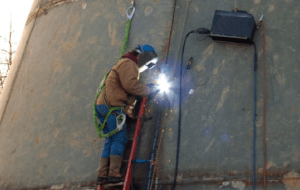
In the safety world, you commonly hear the phrase, “if it’s not documented, it never happened,” and holding true to form, it is becoming more prevalent for companies to take these words to heart.
The OSHA regulation regarding ladder safety, 1917.119(e)(2), states, “Ladders shall be inspected for defects prior to each day’s use, and after any occurrence, such as a fall, which could damage the ladder.”
Tags Document Safety, Include Job Information, & Identify Hazards
We have seen a growing trend with several of our clients to put in place “ladder inspection tags” on all portable ladders, to better document that this inspection is, in fact, taking place. The tags are being used much like the generally accepted scaffold tag. A ladder tag allows for a competent person to inspect the ladder for defects or damage that would require it to be taken out of service prior to use.
Click Link to Access Free PDF Download
“4-Step Sequence For Effective Employee Screening, Hiring, & Placement”
Additionally, they are also using this tag to identify the work being performed while utilizing the ladder, and the opportunity to list additional information to identify hazards and create a safer workplace.
For instance, the tag would serve as documentation that the ladder was inspected by a competent person prior to use, as required, and also list other requirements, such as fall protection, if the work being performed is above the four or six-foot requirement for fall protection, and three-points of contact cannot be maintained by the person performing the work from the ladder.
Resistance To Change
This is a major undertaking and creating quite a stir on the job sites that are now implementing these requirements prior to using a portable ladder. The amount of added work and time required for a person to assume the responsibility has not been feasible. So, in most situations, the ladder user is held responsible for performing the inspection, requiring him/her to “think before they act,” and consider and identify that all safety factors, such as the ladder being properly secured, noting that it is stable and on level ground, that fall protection needs have been considered, and then attaching the ladder tag to indicate that such an inspection has taken place.
As we have seen in the past, by nature we are resistant to change as well as to new or different ways of doing our work. We have seen the same reaction when scaffold tags, Job Safety Assessment (JSAs) or any other revolutionary change has been introduced to the work site. However, we can now look back in retrospect and see the enormous amount of benefit that comes from these documents and in all likelihood, in the future, we will look back and see the benefits of these “ladder inspection tags” as well.
Stay safe, inspect that ladder before use, and consider safety, above all.
Author Kevin Kelley, Medcor, Executive Director Brown Safety Services / Medcor. Medcor helps employers reduce the costs of workers’ compensation and general health care by providing injury triage services and operating worksite health and wellness clinics. Medcor’s services are available 24/7 nationwide for worksites of any size in any industry. Headquartered in McHenry, Illinois, the company operates 174 clinics and provides triage services to over 90,000 worksites across all 50 states and US territories. Medcor’s triage methods are covered by U.S. & foreign patents, including U.S. No. 7,668,733; 7,716,070; & 7,720,692; other patents pending. Medcor is privately held. Learn more at www.medcor.com.
















Hey Kevin Good article , see you here at Flounder soon!!